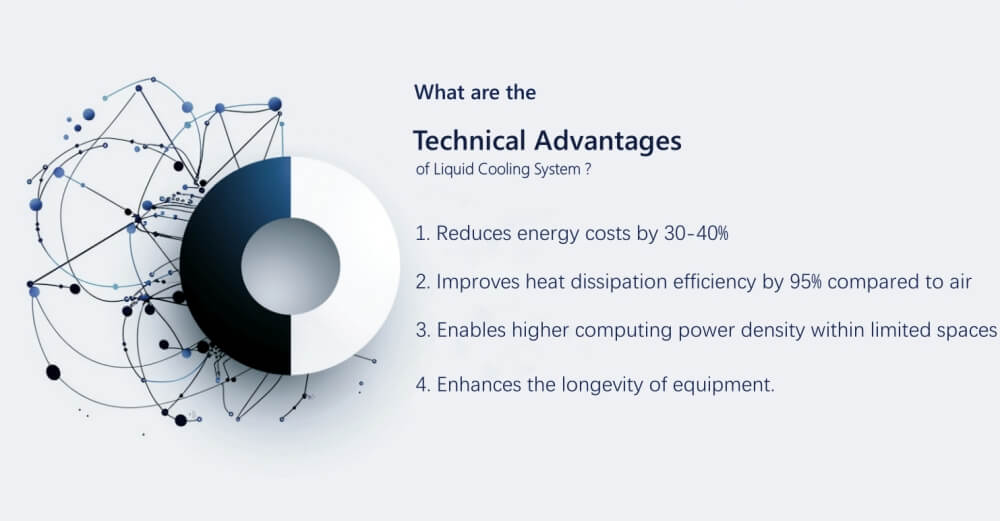Ever wondered why your laptop gets hot during video calls? Now imagine that heat multiplied by thousands – that’s what data centers deal with every day! These digital powerhouses are facing a real challenge: traditional cooling just can’t keep up anymore. It’s like trying to cool down a furnace with a desk fan – it’s simply not enough.
Let’s unpack the key factors pushing data centres toward liquid cooling solutions.
You know that feeling when your computer starts lagging because it’s overheating? Data centers face this same challenge, but on a massive scale. It’s like trying to keep an entire city of computers running smoothly. Conventional air-cooled methods grapple with soaring densities, as modern servers run hotter than ever. This strain sends efficiency and performance plummeting.
Traditional cooling simply can’t keep up with relentless hardware demands. Heat pockets form, fans labour overtime, and costs creep upward. Without a better approach, operators risk instability and forced downtime.
High-density racks generate formidable heat loads. Air-based solutions will fight a losing battle: more fans, larger ducts, and higher energy draw. Ultimately, these cumbersome approaches rack up operating expenses and complexity. As data centres scale, they need more effective, targeted methods that match the intensity of next-generation computing tasks.

Yes, many data centres now deploy liquid cooling data center design frameworks to tame intensive workloads and rising temperatures.
As facilities modernise, liquid cooling data center stock expands. Operators integrate direct liquid cooling data center configurations, shifting from old-school fans to fluid-based systems that manage heat with pinpoint accuracy.
Global players—from hyperscale hubs to edge facilities—are upgrading. This shift isn’t hype. Liquid immersion, cold plates, and coolant circulation networks ensure even complex tasks like machine learning and 3D simulations run smoothly. Adopters report consistent thermal conditions, better resource allocation, and the headroom to experiment with cutting-edge hardware.
Liquid cooling capitalises on fluid’s superior thermal conductivity, allowing tighter rack densities and stable server conditions that air alone can’t achieve.
By directly absorbing heat, these systems enable relentless processing without throttling. Data centers handle heftier loads, slash energy costs, and reduce hardware stress.
Think of liquid cooling as the difference between sipping water through a straw vs. blowing air over ice cubes. Fluid draws heat more efficiently, so hardware stays consistently cooler. This stability matters when balancing hefty computational demands. As a result, managers gain flexible capacity planning and steadier performance across the board.
So, the technical advantages of liquid cooling systems in data centers are:

A handful of liquid cooling data center companies lead the market, innovating solutions that push cooling performance, scalability, and sustainability forward.
These market leaders have refined solutions ranging from immersion cooling to on-chip fluid delivery, ensuring their offerings cater to both established giants and emerging players. Their innovations allow smoother integration with existing infrastructures, guiding data centers toward greener operations that keep pace with technological advancements and regulatory pressures.
It depends on goals, but data center liquid cooling vs air cooling comparisons usually favour liquids for thermal stability and resource efficiency.
Liquid setups reduce hotspots, keep energy draw predictable, and maintain tighter temperature bands. Operators experience fewer operational hiccups and leaner budgets.
By sidestepping the complexity of pumping massive volumes of conditioned air, liquid cooling refines control. Enhanced conductivity means less overprovisioning just to keep temperatures in check. The outcome: a more predictable environment that supports innovations, faster deployment of new technologies, and the agility to respond swiftly to shifting workload patterns.
While initial investments in liquid cooling may appear steep (kind of like buying a hybrid car), the long-term financial and operational returns often justify these expenditures.
Shifting to liquid cooling systems can significantly cut energy bills, reduce maintenance burdens, and extend equipment life, ultimately improving overall return on investment.
Cost models should factor in total lifecycle expenses: power consumption, server replacement rates, and downtime prevention. As data centers continue to grow and workloads become more demanding, the savings from reduced cooling overhead and stable performance accumulate over time, making liquid systems a sound strategic choice.
Retrofitting an existing facility with liquid cooling requires careful planning, from infrastructure assessments to tailored integration strategies.
A phased approach works best. Start small, validate gains, then scale. Engaging experienced liquid cooling data center companies ensures a smooth transition. They provide guidance on compatibility, installation, and ongoing support to maximise efficiency gains.
Key steps include identifying suitable liquid loops, selecting compatible server hardware, and training personnel in maintenance protocols. Thoughtful implementation minimises downtime and avoids unnecessary complexity. Expert vendors customise solutions to meet unique facility requirements, ultimately transforming legacy environments into future-ready hubs capable of tackling modern workloads.
As AI, IoT, and 5G expand, data centers must anticipate denser, more resource-intensive workloads that challenge conventional cooling approaches.
Innovations in AI-powered cooling, mixed cooling solutions, two-phase cooling, green coolants, more intelligent thermal management, these will drive further efficiency, while sustainable strategies align with environmental goals, ensuring data centers remain agile and green.
The cooling roadmap points toward ever-leaner resource use. As chips become more specialised, systems must adapt swiftly. Advanced fluids, compact units, and integrated monitoring ensure each watt of power yields maximum computational output. Tomorrow’s data centres won’t just cope with heat—they’ll anticipate it, adjusting fluid flow and capacity to optimise yield.
Specialised engineering solution providers offer customised, scalable cooling systems and services, guiding data centers through every stage of adoption and refinement.
For instance, XD THERMAL can leverage its extensive manufacturing capabilities and engineering expertise, honed in battery thermal management, to craft bespoke liquid cooling solutions that address unique data center challenges.
XD THERMAL leverages robust manufacturing capabilities to produce custom components that fit existing layouts. Beyond hardware, they offer guidance, validation, and testing support, ensuring smooth adoption. Their industry background informs precise, reliable performance targets. With XD THERMAL’s insight and proven processes, data centres gain confidence in their cooling transitions and remain well-positioned for future expansions.
Liquid cooling revolutionises data centre efficiency, cutting costs, ensuring performance stability, and aligning with tomorrow’s digital demands. Strategic partners help operators implement solutions that transcend today’s thermal limitations. Have questions about how liquid cooling could transform your data center? XD THERMAL’s team is here to help!